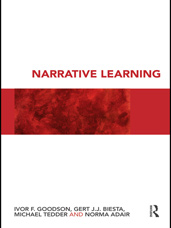Narrative Learning
Towards a Theory of Narrative Learning
The complex ecology of narrative learning
Our case studies leave us with a complex ecology of narratives and narration as would be expected in such an intricate and intimate aspect of human activity. Some of the distinctions that emerge from our studies are important in theorising narrative learning.
The key distinction that emerges is that between the use of life narratives as tools for learning, agency and identity construction and the ongoing process of narration itself as a site for learning. What all our cases show, but is particularly highlighted by Maggie and Diogenes, albeit for different reasons, is that the first category, employment of life narratives as tools can exist in an intensive and active manner without the presence of ongoing and pervasive narration activity. It would seem from our studies that while most people do recount life stories when interviewed, not everybody works with narration as an ongoing internal conversation or external accounting mechanism. Narrative learning then, appears to take place in two ways. Firstly learning can take place by the employment of life narratives as tools for facilitating learning strategies. Secondly learning can take place at the site of ‘narration’ itself, through the ongoing internal conversation and external accounts that are undertaken as a genuinely lifelong process. From this angle, narrative learning is maximal when evidence as a tool in the form of a life narrative and as the site of ongoing narration. There is however a complex ecology to narrative learning. As we have shown, not everybody learns in this way and there are considerable personal variations.
Our case studies indicate that the maximal capacity for narrative learning is reached when life narratives as tools and narration as ongoing activity are active and in a productive balance. In these cases – Christopher, Eva, Russell Jackson – the learning potential and action potential are substantially explored. We might see this as a type of open narrative learning where all the channels for learning are open. The key issue in theorising narrative learning is the issue of balance between the various aspects and dimensions. As we have said before, the case of Paul is significant in that whilst the narrative learning is highly intense and the learning potential considerable, the action potential is not fully explored. Likewise in the case of John Peel we see the development of a life story based on established socially recognized scripts but with virtually no ongoing narration. This is a closed form of narrative learning with virtually no channel between the narrative and narration. As a result the flexibility of response to new life experiences and events is diminished. Diogenes also represents a closed model where the narrative is a finished product, a final script almost, with no ongoing narration or modification although in his case it is the ‘strength’ of the convictions that stem from his narrative learning that allow him to operate in different contexts and under different circumstances, but at the risk of becoming cynical about those situations. In Marie Tuck’s case we see in fascinating detail the transition from closed narrative learning to open narrative learning. The balance of narrative as static tool through to ongoing narration and narrative reformulation changes dramatically. In this case we see the move to narrative learning in action. There the culminating process is open, flexible, a work in progress.
